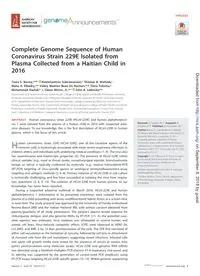
2017 Complete Genome Sequence of Human Coronavirus Strain 229E Isolated from Plasma Collected from a Haitian Child in 20 PDF
Preview 2017 Complete Genome Sequence of Human Coronavirus Strain 229E Isolated from Plasma Collected from a Haitian Child in 20
Complete Genome Sequence of Human Coronavirus Strain 229E Isolated from Plasma Collected from a Haitian Child in 2016 Tania S. Bonny,a,b* Kuttichantran Subramaniam,c Thomas B. Waltzek,c Maha A. Elbadry,a,b Valery Madsen Beau De Rochars,b,d Taina Telisma,e Mohammed Rashid,b J. Glenn Morris, Jr.,b,f John A. Lednickya,b Department of Environmental and Global Health, College of Public Health and Health Professions, University of Florida, Gainesville, Florida, USAa; Emerging Pathogens Institute, University of Florida, Gainesville, Florida, USAb; Department of Infectious Diseases and Immunology, College of Veterinary Medicine, University of Florida, Gainesville, Florida, USAc; Department of Health Services Research, College of Public Health and Health Professions, University of Florida, Gainesville, Florida, USAd; Christianville Foundation School Clinic, Gressier, Haitie; Department of Medicine, College of Medicine, University of Florida, Gainesville, Florida, USAf ABSTRACT Human coronavirus strain 229E (HCoV-229E) and human alphaherpesvi- rus 1 were isolated from the plasma of a Haitian child in 2016 with suspected arbo- virus diseases. To our knowledge, this is the first description of HCoV-229E in human plasma, which is the focus of this article. H uman coronavirus strain 229E (HCoV-229E), one of the causative agents of the common cold, is increasingly associated with more severe respiratory infections in children, elders, and individuals with underlying medical conditions (1–4). The virus also has neuroinvasive and neurotropic properties (5). The presence of HCoV-229E within clinical samples (e.g., nasal or throat swabs, nasopharyngeal aspirate, bronchoalveolar lavage, or saliva) is typically confirmed by molecular (e.g., reverse transcription-PCR [RT-PCR] targeting of virus-specific genes) or serological (immunofluorescence assay targeting viral antigen) methods (3, 6–8). Primary isolation of HCoV-229E in cell culture is technically challenging, and few have succeeded at isolating the virus from respira- tory specimens (3, 6, 9, 10). The isolation of HCoV-229E from human plasma, to our knowledge, has never been reported. During a suspected arbovirus outbreak in March 2016, HCoV-229E and human alphaherpesvirus 1 (information to be presented elsewhere) were isolated from the plasma of a child presenting with acute undifferentiated febrile illness at a school clinic in rural Haiti. The study protocol was approved by the University of Florida Institutional Review Board (IRB) and the Haitian National IRB, with written consent obtained from parents/guardians of all study participants. The patient’s plasma tested negative for chikungunya, dengue, and zika genomic RNAs by RT-PCR (11). As the potential caus- ative agent(s) was unknown, virus isolation was attempted in several human and animal cell lines. Virus-induced cytopathic effects (CPE) were observed in VERO E6, LLC-MK2, and MRC-5 by 14 days postinoculation of the cells. The CPE first consisted of either cell vacuolation or the formation of syncytia, followed by cell lysis or detachment of clumped cells from the cell monolayers, suggesting mixed infections. Infected cells and spent cell growth media were tested for the presence of viruses at various time points postinoculation using molecular assays. HCoV-229E viral genomic RNA (vRNA) was detected using a GenMark multiplex PCR eSensor XT-8 respiratory viral panel, and its identity was supported by the generation of correct-sized PCR amplicons using RT-PCR assays targeting HCoV-229E-specific genes (12–14). Whole-genome sequencing Received 23 October 2017 Accepted 24 October 2017 Published 22 November 2017 Citation Bonny TS, Subramaniam K, Waltzek TB, Elbadry MA, Beau De Rochars VM, Telisma T, Rashid M, Morris JG, Jr, Lednicky JA. 2017. Complete genome sequence of human coronavirus strain 229E isolated from plasma collected from a Haitian child in 2016. Genome Announc 5:e01313-17. https://doi.org/10.1128/ genomeA.01313-17. Copyright © 2017 Bonny et al. This is an open- access article distributed under the terms of the Creative Commons Attribution 4.0 International license. Address correspondence to John A. Lednicky,
